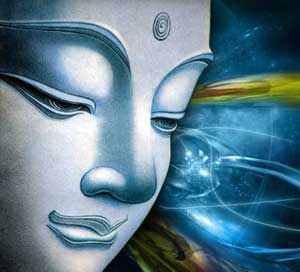
I – Mindfulness of the Body
- 1 – Mindfulness of Breathing
- There are many variations of this exercise. A very basic one is to focus on the sensation of the breath at the nose-tip and to be keenly aware of the entire breath; both in-breath and out-breath are to be watched from beginning through the middle to the very end. A simple two-syllable mantra like “bud-dho” may be used as an aid.
- .
- 2 – Postures of the Body
- The four basic postures are walking, standing, sitting and lying. The exercise here is simply to be aware at all times of the disposition of the body.
- .
- 3 – Clear Comprehension (sampajañña)
- Clear Comprehension of Purpose- Why are you undertaking this action ?
- Clear Comprehension of Suitability- Is this action suitable under the circumstances? (skill-in-means)
- Clear Comprehension of the Domain (of Meditation)- Can this action be incorporated into the practice? Take the meditation into the life.
- Clear Comprehension of Reality- See the three characteristics in all activities. (i.e. impermanence, suffering and not-self)
- 4 – Reflection on the Reality of this Body
- To see the body as a collection of parts; solid and liquid. The traditional list of thirty-two parts;
- hair of the head, hair of the body, nails, teeth, skin, flesh, sinews, bones, marrow, kidneys, heart, liver, membranes, spleen, lungs, bowels, intestines, gorge, dung, bile, phlegm, pus, blood, sweat, fat, tears, grease, snot, spittle, oil-of-the-joints, urine (and brain is added from the commentary)
5 – Reflection on the Material Elements
To see the body as a physical process. The traditional physics is based on the four elements; earth (extension), water (cohesion), air (motility) and fire (energy). Alternatively, modern concepts may be used.
.
6 – the Cemetery Contemplations
These are used to become keenly aware of the impermanence of the body and to break the illusion of immortality. The list given by the Buddha can be taken as a visualization exercise which goes through repulsiveness to tranquillity.
- the festering body (a few days old)
- the corpse being devoured by birds, beasts and worms
- a skeleton held together by tendons, with some flesh and blood remaining
- a skeleton held together by tendons, fleshless, smeared with blood
- a skeleton held together by tendons, fleshless and bloodless
- loose bones scattered about
- bones bleached white by the sun
- bones a year old lying piled in a heap
- rotted bones crumbling to dust.
II – Contemplation of the Feelings
The Feelings (Vedana) are not to be confused with the more complex mental functions called “emotions” . Feelings in the technical sense used here are much more basic. They can be classified in several ways;
- pleasant, neutral, unpleasant
- bodily, mental
- worldly, unwordly
As examples of the last; a worldly pleasant feeling is sense pleasure of any kind (food, sex etc.) an unworldly pleasant feeling is rapture arising from jhana. A worldly unpleasant feeling is grief at loss of possessions, an unworldly unpleasant feeling is distress at slow progress in meditation.
An important note: unseen pleasant feelings lead to craving, unseen unpleasant feelings lead to ill-will (negative craving) and unseen neutral feelings lead to ignorance. The feelings -> cravings link is the key point in the cycle of dependent origination where the process can be transcended and liberation achieved.
III – Contemplation of the Mind (State of Consciousness)
What is the state of mind? Is it with lust or without? With hatred or without? With delusion or without? Is it shrunken? Is it distracted? Is it developed or undeveloped? Is it surpassable or unsurpassable? Is it Is it concentrated or scattered? Is it freed or bound?
This refers to the “background” of mind, the basic level or tone of conscious awareness that is present.
IV – Contemplation of Mind Objects (Dhammas)
- 1 – the Five Hindrances; mental states that lead one astray
- sense-desire, anger, sloth-and-torpor, worry and flurry, skeptical doubt.
These to be countered as follows;- sense-desire -> body meditation (e.g.. 32 parts and/or corpse med.)
- anger -> loving-kindness
- sloth-and-torpor -> change of posture, perception of light
- worry -> mindfulness of breathing
- doubt -> study, asking questions, puja
- 2 – the Five Aggregates of Clinging
- An analysis of all phenomena into five constituents to dispel the idea of a self-entity. The five:
- form
- feeling
- perception
- mental-formations
- consciousness
- 3 – the Six External and Six Internal Sense- Bases
- All consciousness arises through one or the other of these doors;
- eye and form
- ear and sound
- nose and odour
- tongue and flavour
- body and touch
- mind and idea.
- 4 – the Seven factors of Enlightenment
- Investigation of Dhammas
- Energy
- Rapture (Joy)
- Mindfulness
- Tranquillity
- Concentration
- Equanimity.
The first three are to be developed when the mind is dull; the last three when the mind is agitated. Mindfulness is to be developed in all circumstances.
- 5 – the Four Noble Truths
- The Noble Truth of Suffering; birth, sickness, old age, death, not getting what you want, in brief, the Five Aggregates of Clinging
- The Noble Truth of the Origin of Suffering; craving
- The Noble Truth of the Cessation of Suffering; extinction of craving, nibbana
- The Noble Truth of the Path Leading to the Cessation of Suffering; the eightfold path; right view, right intention, right speech, right action, right livelihood, right effort, right mindfulness and right concentration.
From the Satipatthana Sutta: D.22